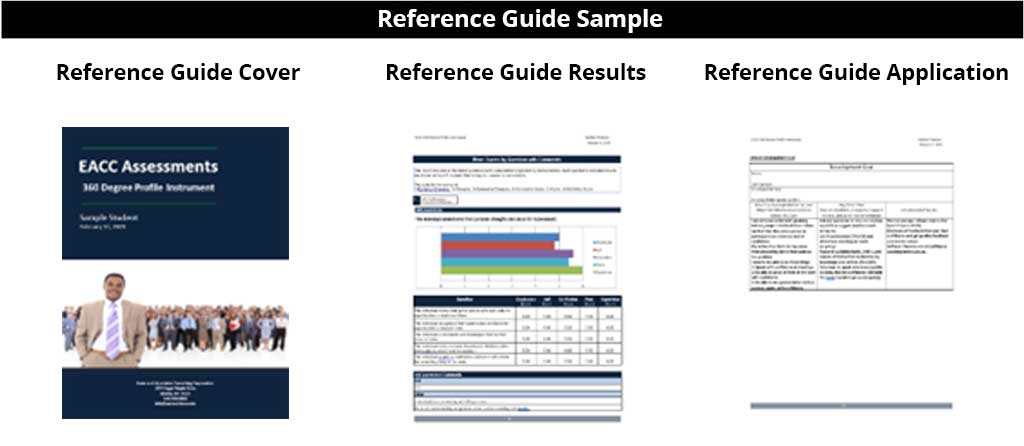Welcome to the EACC 360-Degree Custom Assessment. Let us take a few moments to understand what a 360-degree assessment is and how it operates. The EACC 360-degree assessment collects qualitative (which are comments) and quantitative (which are numerical) data based on your own and the perceptions of other individuals you choose to give you feedback surrounding your leadership capabilities in various areas. Ultimately it gives you a snapshot of your strengths and opportunities for growth as a leader.
The EACC 360-Degree Custom Assessment allows your organization to define and develop, with assistance, topics and accompanying questions that support your inquiry and understanding into a select base of desired questions you desire data on.
The EACC 360-Degree Custom Assessment requires a minimum of ten assessment individual takers for development to occur and for this service to be used.
Minimum of ten of the same customer assessments must be purchased.
This instrument includes an assessment and a reference guide with explanations to assist you in processing and understanding your assessment results. By taking this assessment you have started your journey to understanding yourself better through yourself and others and having additional alternatives in how you respond in various situations.
As with all assessments, we intend to use them for learning and creating awareness. There is no right or wrong answer, and you realize you will have varying proficiency and/or awareness based on the situation with each of them. The goal of the assessment is to broaden your awareness in the components you have comfort in and enhance the components that offer you varying opportunities for growth.
Learning Objectives
This assessment typically focuses on the work environment. It will inquire about the perceptions of yourself, your Supervisor, Peers, Co-Workers, and Employees (if applicable) on various leadership topics.
The assessment will broaden your understanding and awareness in yourself and how others perceive you in the workplace setting. The results will increase your
- ability to accurately recognize your own emotions and stay aware of them as they occur. This includes an awareness of how you tend to respond to specific situations and with specific people.
- ability to evaluate similarities and differences in how you see yourself and how others see you.
- ability to develop a plan(s) to respond to similarities and differences in how you see yourself and how others see you.
- ability to self-manage and enhance aspects of relationships based on communication and actions you do.
Process, Results, and Resource Guide
The EACC 360-Degree Custom Assessment is comprised of ten steps:
- Step One is developing with a consultant topic areas and questions of what you would specifically like evaluated.
- Step Two is the development and review of the final product before implementation.
- Step Three is deciding the most appropriate individuals to give you feedback.
- Step Four is asking for the individuals you choose to give you their commitment to complete the assessment on you.
- Step Five is completing and submitting your respondent form.
- Step Six is completing the assessment on yourself.
- Step Seven is checking in and reminding the individuals you asked to take the assessment, to complete it if they have not.
- Step Eight is processing and interpreting your results.
- Step Nine is valuating for interpretation.
- Step Ten is constructing developmental goals and next steps.
Let us take a moment and explore each step in more detail.
Steps One and Two- Design and Development of Assessment. In this step, you will meet with a facilitator to discuss what you desire to achieve with the use of the assessment. You and the facilitator will develop topic areas and questions that correspond to these objectives. Once developed you and the facilitator will review and finalize the instrument.
Step Three- Deciding the most appropriate individuals to give you feedback. In this step, you pick your evaluators. You are allowed yourself, one supervisor, four peers (that is someone who knows you well though does not necessarily work with you), four co-workers (that is someone who works directly with you), and four employees if they apply to your situation. You may be thinking:
- Who should I pick? When choosing individuals (other than your supervisor and yourself), pick peers and co-workers that you are comfortable with, as well as individuals that may be challenging or uncomfortable. The best results come from a true mixture of people you interact with.
- Is it okay if the individual is located remotely? Yes, remember to pick individuals you interact with regularly.
- Is it okay to pick family members? It is not suggested for this assessment unless you work with them.
Remember, pick a balanced mixture of individuals you connect well with, and those you do not. This will give you a good representation of yourself in the end.
Step Four- Asking for their commitment to complete the assessment on you. In this step, you are encouraged to contact everyone and ask them if they have 20 minutes to complete a 360-degree assessment within the next week. This may be more difficult with individuals that are more challenging for you to communicate with. Ensure that their feedback is critical and much appreciated to your professional growth and that you do encourage unfiltered confidential responses.
Step Five- Completing and submitting your respondent form. In this step, once you have carefully considered and asked individuals to complete your 360-degree assessment of you, you will complete the “Respondent Form†that collects your respondent’s names, email addresses, and title (peer, co-worker, etc.) of each person you would like to complete this assessment on you. Being accurate on what you submit is critical, as any errors cannot be adjusted once submitted. I will express this again; errors cannot be changed. This respondent form will be available to you once payment has been made via the email you will receive with its link.
Step Six- Now that you submitted the respondent form. In this step, it is time for you to look for the assessment request in your email and take a few moments to open the link and complete the assessment yourself. More times than less, individuals forget to take the assessment by “looking at themselves†through their perception.
Step Seven- Checking in With Respondents. In this step remember that individuals are busy, just as you are, and a friendly reminder to ensure they have taken the assessment will yield you more feedback and workable data. Checking in and reminding individuals you asked to take the assessment by many is appreciated.
Remember that, to the second, once you submit the respondent form the survey runs for 21 days. At that time, it closes and your EACC 360-Degree Assessment Report will be generated and emailed to you. Individuals are sent three reminder requests to fill out the assessment during these 21 days until it is completed, though ultimately it is your responsibility to check in with them to ensure they have completed it.
Step Eight- Processing and Interpreting Your Results. In this step, once you receive your EACC 360-Degree Assessment Report (remember it will be emailed two weeks from the date and time you submit the respondent form), you will see that it is broken into numerous areas based on the developed assessment in Steps One and Two. An example of our standard assessment includes nine areas, each area consisting of five questions. The nine areas consist of:
- Self-awareness –Your ability to understand your strengths and areas for improvement.
- Self-Management –Your ability to self-control in expressing your ideas and thoughts with others in a respectful manner.
- Time Management –Your ability to be organized and productively manage tasks.
- Dependability –Your ability to be trusted to do what is expected of you or has been promised by you.
- Team Player –Your ability to work and strategize with others effectively to produce fruitful results.
- Listens Effectively –Your ability to listen and thoughtfully consider new ideas, resulting in others feeling free to express their opinions and suggest improvements.
- Problem Solving –Your commitment to the best possible solution and outcomes.
- Supportive – Your ability to encourage others to attain excellence.
- Maintains Governance –Your commitment to the reputation and success of the organization you represent.
Within each area, you will find a quantitative summary overall chart that captures the results based on the groupings of Self, Supervisor, Peers, Co-Workers, and Employees.
Directly below the chart, you find the five specific questions that make up the overall results, and the response rate from each of the respondent groupings, with quantitative summaries based on the specific questions and grouping shared.
Lastly you will find the qualitative results grouped in two categories, “Selfâ€- that represents your comments, and “Other†that is represented by the compilation of all peers, co-workers, employees, and your supervisor in one grouping.
On the last page of your report, you find a listing of each of the individuals you requested to complete the assessment on you.
Step Nine- Valuating for Interpretation. Most 360-degree assessments end with the reported results leaving the one being assessed, to interpret the results based solely on their perceptions. The EACC 360-Degree Assessment encourages individuals to complete what they consider the other 50% of the assessment, or “Validating the Results.â€Â Validating the results first entails reviewing the results while looking for general themes, generalizations, and possible gaps between the raw scores and comments given. The validation process then takes those observations and discusses them with all the respondents from the last sheet of their report. This is done by setting up an appointment with each of them, knowing if less than a 100% completion rate occurred that some did not do it, to share those assumptions developed by themselves in the hope of uncovering more data and concrete examples to bringing clarity to the understanding and usefulness of the report.
Step Ten- Constructing Developmental Goals and Next Steps. Once a clearer understanding and usefulness of the EACC 360-Degree Assessment results have been uncovered. You will then be able to construct developmental goals to enhance current strengths and challenge opportunities for growth.
In a moment you with take the EACC 360-Degree Assessment to broaden your understanding of strengths and opportunities for growth from the perceptions of yourself, your Supervisor, Peers, Co-Workers, and Employees (if applicable) on various leadership topics. Once you complete the payment process an email will be sent to you with a link to the EACC 360-Degree Assessment Respondent Form directly. Make sure to save this email, as it is your record proof of purchase.




